
The Trump administration’s war on offshore wind has transitioned from symbolic resistance to explicit, systematic dismantling. Federal agencies have, in the past few weeks, revoked permits, issued stop-work orders, and pulled hundreds of millions in funding for port infrastructure against projects already far along in construction and investment. The rationale given: national security. The real-world consequence: freezing billions of capital, sitting out thousands of workers, and undermining a sector crucial to state climate ambition and grid resilience.

1. The Depth of the Offensive
This week, court documents disclosed the administration’s plan to rescind approval by the Bureau of Ocean Energy Management for New England Wind 1, an 800-megawatt Massachusetts wind farm capable of powering about 400,000 homes. This comes after the August suspension of Revolution Wind a 704-megawatt facility off Rhode Island and Connecticut and 80 percent built and previous measures against Empire Wind off New York and an offshore venture in Maryland. Industry observers estimate that over $100 billion worth of investments are locked up in five U.S. offshore wind farms under construction.

2. National Security as a Legal Lever
Interior Secretary Doug Burgum has used turbine interference with radar and the potential threat of “swarm drone” attacks as rationale for pauses. Critics such as Michael Gerrard of Columbia Law School have said that “the mere words ‘national security’ shouldn’t be enough” unless accompanied by concrete evidence. The Department of Defense has maintained a siting clearinghouse since 2011 to prevent such clashes, and the site of Revolution Wind was cleared after consultation with DOD. Research recognizes radar effects, but mitigation by software modifications and operation procedures is firmly established.

3. Engineering and Construction Realities
Offshore wind farms of this magnitude involve multi-year engineering programs: seabed surveys, installation of monopile or jacket foundations, laying of subsea cables, and assembly of turbines in specialized port terminals. Revolution Wind had installed all the foundations and 45 of its 65 turbines prior to the stop order. To stop now exposes them to corrosion, equipment deterioration, and re-mobilization of heavy-lift vessels at great expense assets reserved years ahead of time and used across the world’s projects.

4. Reliability Stakes and Grid Integration
Regional grid operator ISO New England cautioned that postponing Revolution Wind will “increase risks to reliability” and increase consumer bills. High capacity factors of offshore wind sometimes over 45 percent make it an excellent complement to solar, especially for winter peaks and evening demand. Without them, ISO-NE projects energy prices could increase by roughly 50 percent by 2050.

5. Economic Consequences Throughout the Supply Chain
The Revolution Wind shutdown has put out of work over 2,500 jobs, union trades among them and 80 commercial fishermen hired as safety and support personnel. Sea Services North America, a cooperative fleet of fishing boats, has collected $9.5 million from the project so far. “It’s madness to shut down a project that already had permits,” said Jack Morris, a Massachusetts scalloper and project manager. Port cities such as New Bedford risk losing the long-term operations centers, manufacturing plants, and decades of related economic activity.

6. Policy as Bargaining Chip
The pattern of administration follows the Empire Wind incident, where a month’s break ended after New York Governor expressed receptiveness to new natural gas pipelines. Governors of five Northeastern states have charged the White House with “jeopardizing hardworking families” and “giving up leadership to foreign competitors.” Industry supporters caution that employing approved projects as leverage compromises the integrity of federal approvals, providing regulatory uncertainty that discourages international investment.

7. Cost Burden on Developers
Overseas developers are resetting U.S. exposure. Ørsted, developer of Revolution Wind, now requires $9.4 billion to finish its outstanding U.S. developments after not being able to sell an interest in Sunrise Wind due to what it described as “unforeseen developments beyond our control.” Norway’s Equinor has registered close to $1 billion in impairments related to delays. Commentators observe that although inflation and supply chain problems existed before Trump’s return to the presidency, recent political conditions have “spread gasoline on the fire,” hastening project cancellations and write-offs.

8. Losses in Infrastructure and Port Development
The Department of Transportation’s withdrawal of $679 million for port funding brought 12 projects for accepting turbine components and facilitating offshore construction to a halt. The biggest loss $426 million fell on California’s Humboldt Bay, where projects consisted of dredging, wharf extension, and heavy-lift terminals. Ports like these are needed for staging nacelles and blades up to 100 meters or more long, necessitating deepwater berths and heavy-lift cranes.

9. Legal and Regulatory Escalation
Since January, more than 20 measures have been taken by the administration against offshore wind, ranging from tariffs on importing turbines to recasting tax credit eligibility. In July, an Interior Department directive instructed federal lawyers to ask for remand of permits in current lawsuits, an action conservation attorneys describe as “an unprecedented legal attack on clean energy.” Pending litigation, such as state lawsuits against the January 20 permitting halt, may decide whether these tactics hold up in court.

10. Climate and Energy Consequences
Laying in abeyance offshore wind puts at risk state requirements like Rhode Island’s 45 percent 2030 emissions cut. Scientists caution that 2024 was the warmest year yet, with global temperatures at 1.5°C or more above preindustrial levels. Offshore wind’s contribution to coast grid decarbonization cannot be easily replaced; substituting its scheduled capacity with fossil power would cement decades of extra emissions and infrastructure.
The administration’s actions have shifted the offshore wind conversation from engineering challenges to political survival. For developers, investors, and state planners, the question is no longer how to build but whether the federal government will allow them to finish.


